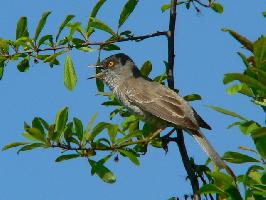
Poids et mesures
| Longueur | 9 cm |
|---|---|
| Poids | 6 g |
| Envergure des ailes | de 13 à 16 cm |
Description de l'animal
The Common Firecrest, scientifically known as Regulus ignicapilla, is a captivatingly diminutive bird that belongs to the kinglet family. This tiny avian marvel is renowned for its vibrant plumage and energetic demeanor, making it a favorite among birdwatchers and nature enthusiasts alike. Its common name is derived from the fiery orange-red patch prominently displayed on the top of the males' heads, resembling a regal crown, which is less pronounced but still visible in females.Physical Description:
The Common Firecrest is one of the smallest birds found in Europe, measuring a mere 9 to 10 centimeters in length and weighing between 5 to 7 grams. Despite its diminutive size, it boasts a striking appearance. The bird's upper parts are predominantly a lush green, providing excellent camouflage against the foliage in which it dwells. Its underparts are a contrasting pale grey to white, with vibrant yellow flanks that add a dash of color to its otherwise subtle underside. The species is easily distinguishable by its distinctive facial markings; a black stripe runs through its eyes, bordered above by a striking white eyebrow stripe and below by a similarly white mustache stripe. The fiery crest that gives the bird its name is most vibrant in males and can be erected during displays of aggression or courtship.
Habitat and Distribution:
The Common Firecrest has a wide range that spans across much of Europe and into the northwestern parts of Africa. Its preferred habitats are coniferous and mixed forests, particularly those rich in undergrowth and dense foliage which provide ample cover and foraging opportunities. During the winter months, some populations migrate to the warmer climates of southern Europe and North Africa, while others remain in their breeding territories year-round, depending on the local climate and food availability.
Behavior and Diet:
This bird is known for its restless energy, constantly flitting from branch to branch in search of insects and spiders, which constitute the bulk of its diet. Its foraging technique is meticulous, as it inspects the underside of leaves and bark crevices, adeptly gleaning small arthropods with its fine, pointed beak. The Common Firecrest is also known for its high-pitched, vibrant song, a series of rapid, melodious notes that males use to establish territories and attract mates during the breeding season.
Reproduction:
The breeding season for the Common Firecrest typically begins in late April and extends through July. The female is responsible for constructing the nest, a painstakingly woven cup of moss, spider webs, and lichen, camouflaged and secured to the branches of a tree or shrub. Into this nest, she will lay between 5 to 11 eggs, which she incubates alone for about two weeks. Both parents share the duty of feeding the hatchlings, which fledge approximately 18 to 22 days after hatching.
Conservation Status:
Currently, the Common Firecrest is classified as Least Concern by the International Union for Conservation of Nature (IUCN), indicating that it is not currently at significant risk of extinction in the wild. Its populations are stable in most of its range, thanks in part to its adaptability to a variety of woodland habitats. However, like many species, it remains vulnerable to the broader threats of habitat destruction and climate change, which could impact its food sources and breeding grounds in the future.
In conclusion, the Common Firecrest is a small but remarkably vibrant and energetic bird, whose fiery crest and lively behavior make it a fascinating subject for study and observation. Its presence enriches the biodiversity of the forests it inhabits, adding a splash of color and a chorus of song to the natural world.
Animaux similaires
Nouvelles photos d'animaux
Top 10 des animaux
- Dolphin gull (Leucophaeus scoresbii)
- Diana monkey (Cercopithecus diana)
- Moustached guenon (Cercopithecus cephus)
- Galápagos tortoise (Geochelone nigra complex)
- Russian tortoise (Testudo horsfieldii)
- Japanese macaque (Macaca fuscata)
- Stone loach (Barbatula barbatula)
- Greek tortoise (Testudo graeca)
- Common flying dragon (Draco volans)
- Colossal squid (Mesonychoteuthis hamiltoni)


